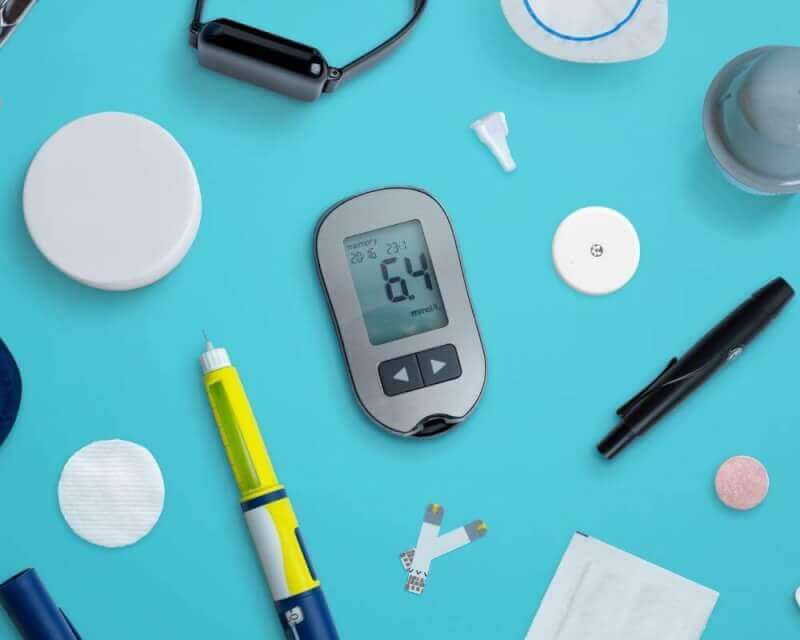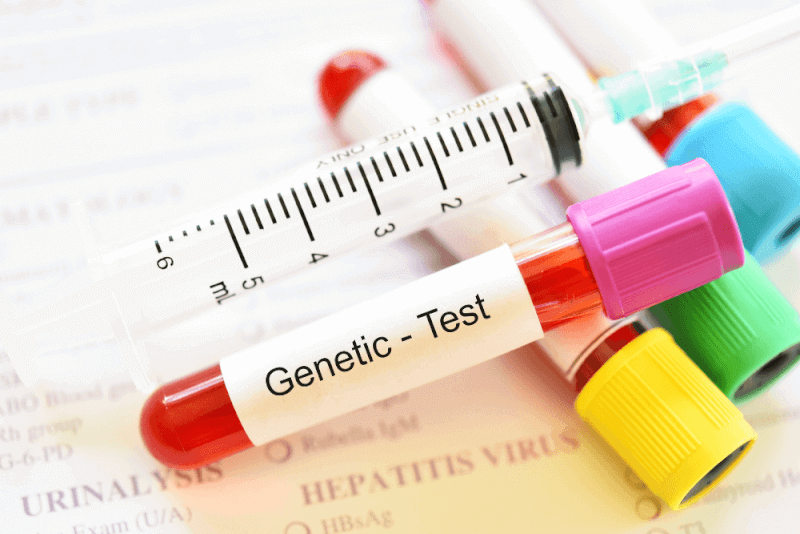What is type 2 diabetes?
In short, in patients with type 2 diabetes, a chronic disease characterized by abnormally high blood sugar levels due to insulin resistance, the insulin hormone produced by the pancreas cannot fully perform its function.
Increased blood sugar as a result of insulin's failure to fulfill its function in the body causes people to have many different complaints. If left untreated, high blood sugar causes negative effects on internal organs and causes people to experience serious health problems.
Insulin is a hormone that is responsible for metabolizing the glucose that people take in with food and transporting it inside the cells. In type 2 diabetes patients, glucose cannot be transported into the cells in the required amount and therefore the energy needs of the cells cannot be met. This leads to damage to tissues and therefore organs.
Diagnostic criteria for type 2 diabetes
Type 2 diabetes is one of the diseases that are usually diagnosed incidentally during a general examination or by tests performed for a different disease. This is because in the early stages of the disease, people do not have the symptoms associated with diabetes. The tests applied to diagnose type 2 diabetes include the following.
Fasting blood glucose
It may be necessary to measure fasting blood glucose more than once. During these measurements, fasting blood glucose is considered normal if it is below 100 mg/dl. If the value is between 100 and 126 mg/dl, it is considered prediabetic. If the result is above 126 mg/dl during the measurement, the person can be diagnosed with diabetes.
Hemoglobin A1C
Also called the 3-month blood glucose test, this test provides information about the course of blood glucose levels in the last 3 months. In order for the hemoglobin level to be considered normal, the measurement result must be below 5.7%. If the value is between 5.7% and 6.4%, it is interpreted as prediabetic. In order for a person to be diagnosed with diabetes, the value must be above 6.5%.
Glucose tolerance test
It is a test applied after people drink a mixture of 75 g of sugar added in 300 ml of water after 12 hours of fasting. The person's values are determined 2 days after consuming the mixture. It is monitored on an hourly basis. If the results of this measurement are below 140 mg/dl, it is considered nomal. It is classified as prediabetic if the value is between 140 and 200 mg/dl and as diabetic if the value is above 200 mg/dl.
Urinalysis
Normally, glucose is not found in urine. However, if glucose is found in the patient's urine, it is seen as an auxiliary criterion for the diagnosis of diabetes.
Type 2 diabetes patients should also be examined by orthopedic and ophthalmologists in order to receive a diagnosis. Because diabetic people often have diabetic foot and retinopathy. The presence of these findings also supports the diagnosis.
Causes of type 2 diabetes
The main reason for type 2 diabetes is that people have less blood glucose lowering response from their muscles, liver and fat. This condition is defined as insulin resistance and is the main cause of type 2 diabetes.
Another cause of type 2 diabetes is the incomplete functioning of the liver. If the liver is not working efficiently, it stores glucose as glycogen and then releases it back into the bloodstream. This causes sudden fluctuations in blood sugar. This also manifests itself as hunger pangs or sleepiness after a meal.
These sudden changes in blood sugar cause damage to the beta cells in the pancreas, which are responsible for insulin production, and therefore do not produce enough insulin hormone. As a result of all these processes, type 2 diabetes occurs.
On the other hand, some people are at greater risk of type 2 diabetes. These risk factors include the following:
- Hypertension patients
- Those with metabolic syndrome
- People with latent diabetes detected
- People with excess fat around the waist
- People with high cholesterol and triglyceride levels
- People over 45 years of age
- Those diagnosed with gestational diabetes during pregnancy
- Having people diagnosed with diabetes in the family
- Those who give birth to babies weighing more than 4 kilos
- GGT elevation
- People with polycystic ovary syndrome
Among the factors that cause type 2 diabetes to be negatively affected are the following:
- Sleeping more or less than usual
- Depression
- Smoking
- Reduced physical activity
Symptoms of type 2 diabetes
Type 2 diabetes is a disease that usually progresses insidiously without causing any symptoms. It is a disease usually seen in people who are overweight, lead a sedentary lifestyle and have a large waist circumference. In addition, since it is one of the genetically inherited diseases, the risk is higher in people with a family history of type 2 diabetes. Among the symptoms frequently encountered in people with type 2 diabetes are the following:
- Early onset and rapidly progressing dementia
- Sudden and excessive hunger
- Memory loss in old age
- Night hunger
- Losing weight without dieting
- Significant increase in water consumption
- Diabetic foot
- Frequent urination
- Erectile dysfunction in men
- Waking up at night with the need to urinate
- Insomnia
- Resistant fungal infections of the genital area and skin
- Numbness in the arms and legs
- Blurred vision
- Floaters in the visual field
- Dark brown spots on the skin, especially in the armpit and groin areas
- Feeling tired for a long time
- Resistant and frequently recurrent infections
Complications of type 2 diabetes
If type 2 diabetes, one of the chronic diseases, is not managed properly, it causes many serious complications. These complications include the following.
Cardiovascular diseases
Failure to manage type 2 diabetes properly primarily affects the cardiovascular system. Diabetes, which primarily causes hardening of the arteries, also causes diseases such as high blood pressure and stroke.
Nerve damage in the limbs
Diabetes is a disease that also affects the nerves. Symptoms of this condition, called neuropathy, include tingling and numbness in the big toes. In addition, heart rhythm disorders are seen when type 2 diabetes causes damage to the heart nerves. Symptoms that can be seen in this case include diarrhea, nausea and constipation.
Kidney diseases
One of the most common complications of type 2 diabetes is kidney disease. If kidney damage progresses, patients may need dialysis or a kidney transplant.
Eye damage
The progression of diabetes leads to damage to the blood vessels that supply the retina, which can lead to blindness. It also increases the risk of eye diseases such as cataracts and glaucoma.
Skin diseases
Another complication caused by type 2 diabetes is fungal and bacterial skin infections. If these infections are not treated in time, they can lead to wounds that heal late and have a serious clinical picture.
Hearing impairment
Type 2 diabetes patients are prone to infections, which can also lead to hearing loss.
Sleep apnea
The main cause of sleep apnea in patients with type 2 diabetes is obesity. Since obesity causes both diseases, sleep apnea is often seen in patients.
Dementia
Patients with type 2 diabetes are more likely to develop Alzheimer's disease and related dementia than the general population. If blood sugar is not under control, memory is directly affected.
Type 2 diabetes treatment methods
The treatment of type 2 diabetes patients is divided into 3 steps. These basic elements are as follows:
- Ensuring a healthy lifestyle: this includes eating a balanced and healthy diet, exercising regularly and quitting smoking.
- Controlling blood sugar with appropriate agents: in this treatment phase, patients are given diabetes medications that they can take orally or use as injections.
- Treatment of comorbidities and symptom relief: this stage of treatment involves reducing the risk of or treating complications associated with type 2 diabetes, such as obesity, hypertension and dyslipidemia.
For patients in the prediabetic period, the recommended treatment includes the following:
- Walking for 30 minutes a day and 150 minutes a week
- Low-fat, low-calorie and high-fiber foods should be consumed
- Refined carbohydrates and sugar should be avoided
- Quitting habits such as smoking and alcohol
Type 2 diabetes surgery
Metabolic surgery, which is an operation that can be applied to both type 2 diabetes and obesity patients, does not completely cure type 2 diabetes. Instead, it keeps blood sugar under control. If this operation is successful, the need for medical treatment is significantly reduced.
It is a preferred method in patients where other treatment methods are not sufficient and the disease progresses and causes serious complications. With this method, the effect of insulin, which is produced in the body but cannot be used sufficiently by the body, is increased. In addition, it significantly improves the quality of life of patients in the long term as it reduces the risk of complications.
Metabolic surgery is a surgical method applied with the closed method. The common features of these surgeries, which are applied with different methods, are the reduction of stomach capacity and the creation of shortcuts for nutrients to reach the small intestine in a shorter way.
Insulin treatment of type 2 diabetes
Drug therapy, which is one of the 2 treatment steps of type 2 diabetes, helps to control blood sugar. The medicines used for this purpose are divided into 3 groups:
- Those in the sulfonylurea class increase insulin secretion. In this way, it makes the body more sensitive to the hormone insulin.
- Biguanides, on the other hand, use existing insulin levels to allow more sugar into the cells. This lowers blood sugar levels. They also reduce sugar absorption in the large intestine. It is the preferred drug group especially in overweight patients.
- Glinides, on the other hand, stimulate beta cells in the pancreas for a short time, reducing the increase in postprandial blood sugar after meals.
- Drugs that increase sensitivity to insulin reduce insulin resistance. In addition, these drugs cause edema in the body and increase the weight by 2 to 3 kilograms.
Exercise in type 2 diabetes
People with type 2 diabetes also need to include regular exercise in their lives. However, there are some issues to be considered at this stage. These include the following:
- First of all, it is necessary to determine a suitable exercise program for the person.
- Exercises should be started with short periods of time, such as 5-10 minutes, and then the duration should be increased.
- Care should be taken to exercise regularly every day and cotton socks should be worn during exercise.
- Insulin should not be administered to muscles that will be actively working during exercise.
- Exercise should not be started on an empty stomach.
- Care should be taken against the risk of low blood sugar during exercise. For this reason, blood sugar should be measured and people should carry simple sugars such as sugar cubes and fruit juice with them during exercise.
Nutrition in patients with type 2 diabetes
Nutrition, which is one of the most important treatment steps of type 2 diabetes, is also the determination of the correct diet that keeps blood sugar in balance. Adequate and balanced nutrition is important at this stage. When adjusting their nutrition programs, the proportions of fat, protein and carbohydrates they should consume on a daily basis should be adjusted. They should organize their meal pattern as 3 main meals and 3 snacks. In addition, calcium-rich foods such as milk and dairy products should be consumed at main meals. This is because calcium has a significant effect on the sudden drop and rise of blood sugar. In addition, people should consume foods with a low glycemic index.
Insulin use in patients with type 2 diabetes
The use of insulin is among the last treatment options to be preferred in type 2 diabetes patients. Among the features that appear to be present in patients who will use insulin are the following:
- If blood glucose levels do not decrease despite other treatment methods
- Patients undergoing surgery
- Complications due to diabetes
- Periods of surgery
- Diabetes patients with foot ulcers
- People diagnosed during pregnancy and unable to maintain blood glucose levels
- People who have severe infections and cannot recover
How to monitor blood glucose at home?
People with type 2 diabetes should measure their blood glucose levels several times a week. These measurements have an important place in determining the diet of dietitians and understanding the effects of the foods consumed on blood sugar.
Patients with type 2 diabetes who use medication in their treatment should take these measurements 4 times a day. This test, which should be performed before morning, noon, evening and night meals, can also be requested to be performed before and 2 hours after different meals within a week. The frequency with which blood glucose is measured is determined by experts. It is usually sufficient for people with type 2 diabetes to perform blood glucose tests twice a week, 2 days a week.
Stages of type 2 diabetes
Type 2 diabetes goes through different stages, from the stage of diagnosis to the period of severe complications. These stages are as follows.
Phase 1
At this stage, although insulin is secreted in the body, the liver, fat and muscle cells cannot get enough glucose. This increases insulin levels in the body. Due to the high insulin level, people's blood sugar levels are at a normal level. A glucose loading test is required to diagnose the disturbance in the insulin and glucose cycle in the body. This period, also called the prediabetic period, is also called impaired glucose tolerance.
Phase 2
This stage is also called prediabetic. The difference from the first stage is that the adverse effects on glucose levels are seen with direct blood tests. In this period, popularly called hidden sugar, the capacity of the hormone insulin is not effective enough to keep blood sugar at a normal level. Although blood sugars are above normal in people at this stage, they are not high enough to be diagnosed with diabetes.
Phase 3
At this stage, blood glucose levels are at a level where patients can be directly diagnosed with diabetes. Diabetes can also cause tissue damage in some organs. Patients in this period need medication or insulin treatment to lower blood sugar levels.
Phase 4
People at this stage have damage to both small and large blood vessels due to high blood sugar. There are also health problems in various organs. The kidneys are the most important of these. These problems include kidney and heart failure, neuropathy due to peripheral nerve damage and retinopathy.
End-stage diabetes
During this period, patients develop renal failure. Patients therefore need to undergo dialysis. In addition, complications due to diabetes during this period can be fatal.
The difference between type 1 and type 2 diabetes
The most important feature that distinguishes type 1 and type 2 diabetes is that in type 1 diabetes, insulin is either not secreted at all or not secreted sufficiently. In type 2 diabetes, insulin is secreted sufficiently but cannot fulfill its function. Apart from this, the differences between type 1 and type 2 diabetes include the following:
- Type 1 diabetes can be seen in all age groups, especially in children. However, type 2 diabetes is usually seen in people over middle age and overweight.
- In patients with type 1 diabetes, insulin treatment starts immediately. However, in type 2 diabetes patients, it is primarily a matter of balancing blood sugar with medication and diet.
Insulin insensitivity
Insulin secreted by the pancreas is responsible for controlling blood sugar. However, due to the resistance of peripheral tissues to the hormone insulin, the response to insulin is not as it should be. This condition is called insulin insensitivity. Medicines and exercise are used to treat insulin insensitivity.
Diet list for type 2 diabetes patients
The primary goal of type 2 diabetes patients should be to reach their ideal weight. People losing weight increases insulin sensitivity and stabilizes blood sugar. However, one should not act unconsciously in the weight loss process and should seek support from a nutritionist.
What type 2 diabetics should pay attention to in their diet
The main points that type 2 diabetes patients should pay attention to while creating their diet are the following:
- First of all, attention should be paid to water consumption. For this, people should consume 30-35 ml of water per kilogram of weight they have.
- It is recommended that they eliminate foods with a high glycemic index from their diet.
- If foods with a high glycemic index are consumed, foods high in fat or protein should be added.
- Monounsaturated or polyunsaturated fats should be preferred over saturated fats. Low-fat meats should be preferred in both white and red meat consumption.
- Fish prepared by grilling should be preferred at least 2 times a week.
- It should be ensured that the dairy products consumed are low-fat or half-fat.
- Seeds such as black cumin and flaxseed increase insulin sensitivity. They should therefore be included in the diet.
- In fruit preferences, especially those consumed with their peels should be preferred.
- Fast food and junk food should be avoided.
- Processed meat products should be avoided.
- Sugary and sherbet desserts should not be consumed.
- Pastries should be avoided.
- Refined flours should not be used.
- Alcohol and smoking should be stopped.
- Fruits and vegetables rich in pulp content should be consumed.
- Foods such as rice, potatoes and peas have a high glycemic index, so they need to be accompanied or supplemented with protein-rich foods.
- They should include foods with high antibiotic properties such as onions and garlic in their diet.
- Portion control should be done in dried fruit consumption.
Foods that type 2 diabetics can consume
Among the foods that type 2 diabetes patients can consume by portion control are the following:
- Legumes
- Half-fat red and white meat
- Crusted fruits
- Egg
- Vegetables with low starch content
- Half-fat milk and dairy products
- Oilseeds such as walnuts and hazelnuts
- Functional foods such as quinoa, oats
- Olive oil, sunflower oil and linseed oil
- Avocado
- Lightly salted olives
Foods that people with type 2 diabetes should avoid
Among the foods that type 2 diabetes patients should completely remove from their diet or consume in small amounts are the following:
- Butter
- Tail fat
- Interior fat
- Margarine
- Fast food
- Junk food
- Jam and marmalade
- Foods prepared by frying or roasting
- Packaged ice cream
- Large amounts of strong and strong tea, coffee
- Delicatessen products
- Chips
- Salty and fatty cheese varieties
Patients should also be careful about their cholesterol consumption. They should make sure that the cholesterol they consume with food is not more than 300 mg. Therefore, they should limit high-fat foods such as milk and dairy products, animal proteins, shellfish, eggs and offal.
Finally, another nutrient that type 2 diabetes patients should restrict is salt. Salt consumption, which plays a role in the reabsorption of glucose in the kidneys, should be limited to 1 teaspoon per day.
How do people with type 2 diabetes lose weight?
Diabetics are usually above their ideal weight. In the treatment of the disease, it is a priority to get them down to their ideal weight. Because with weight loss, total fat volume decreases and insulin activity increases. This results in glycemic improvement. In addition, the risk of damage to blood vessels, nerves and kidneys is reduced.
Lifestyles, economic status, comorbidities and medications used by patients with type 2 diabetes should be taken into consideration in the diet plans to be created for weight loss.
According to the World Health Organization, a weight loss of 0.5 to 1 kg per week or 2 to 4 kg per month is considered healthy. Patients should also support their diet with exercise. It is possible for patients to lose weight, reduce the doses of the drugs they use or stop them completely.



















